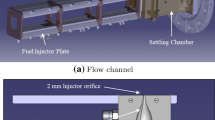Abstract.
The nature of extinction of turbulent unforced and forced symmetric opposed methane-air flames with lean equivalence ratios was examined qualitatively with photographs and chemiluminescence images. Thermocouples and a laser Doppler velocimeter quantified the temperature and velocity in the stagnation plane. Thus, local and complete extinction were related to high local mean strain rates deduced from the velocity measurements. A preliminary investigation of ignition is also described.
The photographs of unforced flames showed that their axial position was unstable with nozzle separations of 2.0 exit diameters (D) and greater, while experimental access was restricted with separations less than 0.2 D. This defined a range of nozzle separations over which the arrangements could be used to examine extinction and the photographs showed further that it occurred only with single-brush flames.
The effects of equivalence ratio, bulk velocity and nozzle separation were examined with reference to the condition 0.7, 2.00 ms–1, 0.4 D. Twin-brush flames were observed at richer equivalence ratios, smaller bulk velocities or larger nozzle separations and these merged into single-brush flames that eventually extinguished with leaner mixtures, higher velocities or smaller separations. Nozzle separations of 1.0 D or greater had near-uniform profiles of strain rate in the stagnation plane, while smaller values led to an increase from the axis to a peak at the edge of the impingement region. The amplitude of the peak increased as the separation was reduced. Thus, the flames quenched from large to small radii at the smaller separations. Complete extinction occurred when the local mean strain rate at the nominal stagnation point exceeded a critical value, quantified here as a function of equivalence ratio. The strain rates at the stagnation plane were at least 40% greater with combustion than with isothermal flow and caused incomplete combustion, lower temperatures and non-linear dependence of local strain rate on bulk velocity and nozzle separation. Measurements of instantaneous and fluctuating quantities in unforced flows provided evidence of local intermittent extinction and relight as a consequence of instantaneous strain rates above and below the critical value. When the amplitude of the fluctuations was further increased by oscillations, imposed with acoustic drivers, twin-brush flames merged to a single brush and the critical mean strain rate decreased. A reduction in the frequency of oscillations had the same effect and extinction times were greatly reduced by modest increases in bulk velocity or a reduction in nozzle separation.
Photographs indicated that ignition occurred with bulk velocities up to 15% greater than the extinction limit, but lasted for short times that decreased with bulk velocity and increased in the presence of a permanent pilot flame.
Similar content being viewed by others
Author information
Authors and Affiliations
Additional information
Electronic Publication
Rights and permissions
About this article
Cite this article
Korusoy, .E., Whitelaw, .J. Extinction and relight in opposed flames. Exp Fluids 33, 75–89 (2002). https://doi.org/10.1007/s00348-002-0454-3
Received:
Accepted:
Issue Date:
DOI: https://doi.org/10.1007/s00348-002-0454-3




